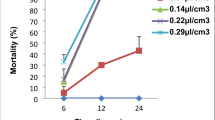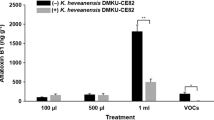Abstract
Soybean (Glycine max L.) grain samples with moisture content (MC) varying between 11.3 and 17% (equilibrium relative humidity, respectively, 66.5, 73.1, 79.7 and 85.4% at 25°C) and inoculated with conidia of Aspergillus glaucus were stored for 135 days at 25 ± 2°C, and fumigated with mustard essential oil (MEO) at the rate of 50 or 100 μL/L. Deterioration of the samples was assessed by estimating the increase of colony forming units (CFU) and free fatty acid (FFA) accumulation. Although the values of these indicators increased with increasing MC and storage period, with or without fumigation, the rate of increase was very slow in the fumigated samples. In grains at 17% MC, the CFU number was 103-fold and FFA content was 6-fold higher in non-fumigated grains compared with the grains fumigated with 100 μL MEO/L, after 4.5 months of storage. No visibly moulded grains were found in the fumigated samples, while such grains were abundant in non-fumigated samples at 17 or 14.8% MC after 45 or 75 days of storage, respectively. The retardation of fungal growth and FFA accumulation appeared to be due to reduced Aspergillus inoculum on the grain surface. There was a significant positive correlation between CFU counts and FFA content. The results of this study suggest that MEO can be used as an eco-friendly and safe antifungal fumigant to prolong storage life of soybeans. Additional keywords: allyl isothiocyanate, biodeterioration, oilseeds grain storage, storage fungi. Australasian Plant Pathology Society 2009
Similar content being viewed by others
References
AOAC (1998) ‘Method 939.05. Official methods of analysis of the Association of Official Analytical Chemists.’ 16th edn. (AOAC: Gaithersburg, MD)
Bankole SA (1996) Effect of ethylene oxide and methyl formate fumigation on seed mycoflora and germination of some stored oilseeds in Nigeria. Crop Research Hisar 11, 224–227.
Bhattacharya K, Raha S (2002) Deteriorative changes of maize, groundnut and soybean seeds by fungi in storage. Mycopathologia 155, 135–141. doi: 10.1023/A:1020475411125
Cahagnier B, Lesage L, Richard Molard D (1993) Mould growth and conidiation in cereal grains as affected by water activity and temperature. Letters in Applied Microbiology 17, 7–13. doi: 10.1111/ j.1472-765X.1993.tb01423.x
Christensen CM (1967) Increase in invasion by storage fungi and fat acidity values of commercial lots of soybean stored at moisture contents of 13.0-14.0%. Phytopathology 57, 622–624.
Christensen CM, Kaufmann HH (1974) Microflora. In ‘Storage of cereal grains and their products’. (Ed. CM Christensen) pp. 158–192. (AACC: St Paul, MN)
Costa RR, Sousa AH, Faroni LRA, Dhingra OD, Pimentel MAG (2006) Toxicity of mustard essential oil to larvae and pupas of Sitophilus zeamais (Coleoptera: Curculionidae). In ‘Proceedings of the 9th international working conference on stored product protection, Passo Fundo’ (Eds I Lorini, B Bacaltchuk, H Beckel, D Deckers, E Sundfeld, JP dos Santos, JD Biagi, JC Celaro, LRD’A Faroni, L.de O. F. Bortolini, MR Sartori, MC Elias, RNC Guedes, RG da Fonseca, VM Scussel) pp. 908–913.
Dhingra OD, Sinclair JB (1995) ‘Basic plant pathology methods.’ 2nd edn. (Lewis Publishers: Boca Raton, FL)
Dhingra OD, Jham G, Napoleão IT (1998) Ergosterol accumulation and oil quality changes in stored soybean invaded by Aspergillus ruber (A. glaucus group). Mycopathologia 143, 85–91. doi: 10.1023/ A:1006954506895
Dhingra OD, Costa MLN, Silva GJ Jr (2004) Potential of allyl isothiothiocyanate to control Rhizoctonia solani seedling damping off and seedling blight in transplant production. Journal of Phytopathology 152, 352–357. doi: 10.1111/j.1439-0434.2004.00855.x
Dorworth CE, Christensen CM (1968) Influence of moisture content, temperature and storage time upon changes in the fungus flora, germinability and at fat acidity values of soybean. Phytopathology 58, 1457–1459.
Gibson DM, Kennelly JJ, Aherne FX, Mathison GW (1988) Efficacy of sulfur dioxide as a grain preservative. Animal Feed Science and Technology 19, 203–218. doi: 10.1016/0377-8401(88)90085-5
Hara M, Mochizuki K, Kaneko S, Iiyama T, Ina T, Etoh H, Kuboi T (2003) Changes in pungent components of two Wasabia japonica Matsum cultivars during the cultivation period. Food Science and Technology Research 9, 288–291. doi: 10.3136/fstr.9.288
Hocking AD, Banks HJ (1991) Effect of phosphine fumigation on survival and growth of storage fungi in wheat. Journal of Stored Products Research 27, 115–120. doi: 10.1016/0022-474X(91)90021-4
Kennedy BW (1964) Moisture content, mold invasion, and seed viability of stored soybeans. Phytopathology 54, 771–774.
Mari M, Bertolini P, Pratella GC (2003) Non-conventional methods for the control of post-harvest pear diseases. Journal of Applied Microbiology 94, 761–766. doi: 10.1046/j.1365-2672.2003.01920.x
Mari M, Leoni O, Bernardi R, Neri F, Palmieri S (2008) Control of brown rot on stonefruit by synthetic and glucosinolate-derived isothiocyanates. Postharvest Biology and Technology 47, 61–67. doi: 10.1016/ j.postharvbio.2007.06.003
Mathison GW, Engstrom DF, Kennelly JJ, Roth L, Beck BE (1989) Efficacy of anhydrous ammonia and sulfur dioxide as preservatives for highmoisture grain and their effect on the nutritive value of barley for growing-finishing cattle. Canadian Journal of Animal Science 69, 1007–1020.
Mayton HS, Olivier C, Vaughn SF, Loria R (1996) Correlation of fungicidal activity of Brassica species with allyl isothiocyanate production in macerated leaf tissue. Phytopathology 86, 267–271. doi: 10.1094/ Phyto-86-267
Mills JT, Wood SM (1994) Factors affecting storage life of farm-stored field peas (Pisum sativum L.) and white beans (Phaseolus vulgaris L.). Journal of Stored Products Research 30, 215–226. doi: 10.1016/0022-474X(94) 90049-N
Milner M, Geddes WF (1946) Grain storage studies. III. The relation between moisture content, mold growth, and respiration of soybeans. Cereal Chemistry 23, 225–246.
Mondal GC, Nandi B (1984) Role of fungi on oil quality of stored seeds of sesame, rapeseed and linseed. Journal of Food Science 49, 1394–1395, 1400. doi: 10.1111/j.1365-2621.1984.tb14999.x
Mukherjee PS, Nandi B (1997) Efficacy of binary combinations of some antifungal compounds as seed preservative. Journal of Mycopathological Research 35, 143–146.
Nielsen PV, Rios R (2004) Inhibition of fungal growth on bread by volatile components from spices and herbs, and the possible application in active packaging, with special emphasis on mustard essential oil. International Journal of Food Microbiology 60, 219–229. doi: 10.1016/S0168-1605 (00)00343-3
Paes JL, Faroni LRA, Dhingra OD, Campos SC, Sousa AH (2006) Efeito do óleo essencial de mostarda sobre Sitophilus zeamais (Coleoptera: Curculionidae) e em grãos de milho armazenados. In ‘Proceedings of the 25th Brazilian congress of agriculture engineering, João Pessoa. Expanded summary’. (Ed. MERM Cavalcanti Mata) pp. 2–4.
Pronyk C, Abramson DD, Muir WE, White NDG (2006) Correlation of total ergosterol levels in stored canola with fungal deterioration. Journal of Stored Products Research 42, 162–172. doi: 10.1016/j.jspr.2004.12.004
Punia RC, Dahiya OS, Wilson DM, Wilson JP (2002) Propionic acid treatment prolongs storage and inhibits lipolytic processes in cracked pearl millet feed grain. International Sorghum and Millets Newsletter 41, 80–81.
Saniewska A, Dabrowska B, Majewska A (2004) Antifungal activity of horseradish (Armoracia rusticana Gaertn.) endogenic compounds. Vegetable Crops Research Bulletin 61, 121–131.
SAS (1989) SAS/STAT User’s Guide, Version 6, Fourth Edition, Volume 1. Cary, NC: SAS Institute Inc.
Saxena J, Munimbazi C, Bullerman LB (2001) Relationship of mould count, ergosterol and ochratoxin A production. International Journal of Food Microbiology 71, 29–34. doi: 10.1016/S0168-1605(01)00584-0
Schnurer J, Jonsson A (1992) Ergosterol levels and mould colony forming units in Swedish grains of food and feed grade. Soil and Plant Science 42, 240–245.
Torres M, Viladrich R, Sanchis V, Canela R (1992) Influence of age on ergosterol content in mycelium of Aspergillus ochraceus. Letters in Applied Microbiology 15, 20–22. doi: 10.1111/j.1472-765X.1992. tb00713.x
Wang CY (2003) Maintaining post harvest quality of raspberries with natural volatile compounds. International Journal of Food Science & Technology 38, 869–875. doi: 10.1046/j.0950-5423.2003.00758.x
White DG, Coates ST (1998) Effect of post harvest application of P-7 grain preservative on storage fungi of corn during ambient air drying and storage. Applied Agriculture Engineering 14, 63–68.
White NDG, Sinha RN, Muir WE (1982) Intergranular carbon dioxide as an indicator of deterioration in stored rapeseeds. Canadian Journal of Agriculture Engineering 24, 43–49.
Winther M, Nielsen PV (2006) Active packaging of cheese with allyl isothiocyanate, an alternative to modified atmosphere packaging. Journal of Food Protection 69, 2430–2435.
Yaremcio BJ, Mathison GW, Engstrom DF, Roth LA, Caine WR (1991) Effect of ammoniation on the preservation and feeding value of barley grain for growing-finishing cattle. Canadian Journal of Animal Science 71, 439–455.
Author information
Authors and Affiliations
Corresponding author
Rights and permissions
About this article
Cite this article
Dhingra, O.D., Jham, G.N., Rodrigues, F.A. et al. Retardation of fungal deterioration of stored soybeans by fumigation with mustard essential oil. Australasian Plant Pathology 38, 540–545 (2009). https://doi.org/10.1071/AP09040
Received:
Accepted:
Issue Date:
DOI: https://doi.org/10.1071/AP09040




